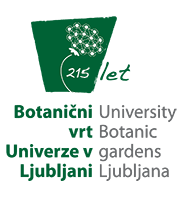REGULAR OFFER:
- Heralds of spring (age: 4 years and up)
- Hide and Seek with Plants (age: 5 years and up)
- Planting or making sprouters (age: 4-8 years)
- Wonderland world of trees (age: 6 years and up)
- Carnivorous plants (age: 6 years and up)
- Puddle (age: 4 years and up)
- Honey plants (age: 6 years and up)
- Imaginative plants (age: 6 years and up)
- Auntie Autumn (age: 4-8 years)
- Pumkin the Pumpkin and Halloween (age: 4 years and up)
- Creating with plants (age: 4 years and up)
-
Heralds of spring (age: 4 years and up)
The celebration is started with the game and followed by adveturous walk through the garden: we touch the plants, smell them, talk about curiosities from the world of plants, take a peek in a tropical glasshouse, tell a poem, story or a riddle, depending on the age of the children. We focus on heralds of spring – snowdrops, primroses, Christmas roses, crocus, winter aconites... We also present bushes that flower in winter: witch-hazel, winter sweet … After a walk, chidren can eat and drink, then they plant their own plant and take it home with them or create picture with heralds of spring or modelas of heralds of spring. Older children can do both: creating images with heralds of springor models of heralds of spring and planting. Afterwards it is time for celebration, and if there is still enough time, we finish with a game. In case of bad weather, the program is carried out in the glasshouse and in the classroom.
Performed in early spring when these plants bloom in the garden. -
Hide and Seek with Plants (age: 5 years and up):
The celebration is started with the game and followed by adveturous walk through the garden: we touch the plants, smell them, talk about curiosities from the world of plants, tell a poem, story or a riddle, depending on the age of the children and season. The guide presents some interesting plants that are also included in the search of the hidden treasure. After a walk, chidren can eat and drink, then they search for the hidden treasures. Children get cards with description of plants and try to identify the plants by description and find it, for the youngest, the descriptions are accompanied by images of plants. Guide accompanies children and helps them. As the treasure, children get sweets, but it is also an option that parents bring gifts for all children. Afterwards it is time for celebration, and if there is still enough time, we finish with a game. You can combinate treasure hunt with planting. In case of bad weather, the entire program – an adventurous walk and treasure hunt, is carried out in glasshouse.
Performed throught the year. -
Planting or making sprouters (age: 4-8 years):
The celebration is started with the game and followed by adveturous walk through the garden: we touch the plants, smell them, talk about curiosities from the world of plants, tell a poem, story or a riddle, depending on the season. After a walk, chidren can eat and drink, then they plant their own plant and take it home with them. Afterwards it is time for celebration, and if there is still enough time, we finish with a game. The selection of plants depends on season.
Instead of planting plants, children can make a real sprouters and sow seeds. They decorate sprouters and at home observe how seed grows. On adventurous walk we can focus on woody plants and then the trees can be planted. In case of bad weather, the entire program – an adveturous walk and planting, is carried out in the glasshouse. Making of sprouters take place in the classroom.
Performed throught the year. -
Wonderland world of trees (age: 6 years and up):
The celebration is started with the game and followed by adveturous walk through the garden: we touch the plants, smell them, look for fruits, talk about curiosities from the world of plants, take a peek in a tropical glasshouse, tell a poem, story or a riddle, depending on the age of the children and season. We focus on woody plants: bushes and trees, get to know a few deciduous trees and conifers, the difference between bush and tree, trees from the time of dinosaurs… We measure the thickest tree in the garden and compare it with a thickness of the thickest representative of its kind in Slovenia. After a walk, chidren can eat and drink, then they have the task to find those parts of trees that belong togethers from the mixture, try to determine which cone belongs to which tree, make prints of bark. Afterwards it is time for celebration, and if there is still enough time, we finish with a game. Children can also plant trees.
Performed throught the year. -
Carnivorous plants (age: 6 years and up):
The celebration is started with the game and followed by adveturous walk through the garden: we touch the plants, smell them, talk about curiosities from the world of plants, tell a poem, story or a riddle, depending on the age of the children and season. We focus on carnivorous plants, explain why they catch insects, and children take a closer look with the help of magnifiers at species that grow in the glasshouse. After a walk, chidren can eat and drink, then they create a model of carnivorous plants. Afterwards it is time for celebration, and if there is still enough time, we finish with a game.
Performed throught the year. -
Puddle (age: 4 years and up):
The celebration is started with the game and followed by adventurous walk through the garden: we touch the plants, tell a poem, story or a riddle, depending on the age of the children and season. We focus on aquatic and marsh plants, we also take a look at the animals that live in our puddle. Children can try to catch animals with nets from our pools. After a walk, children can eat and drink, then youger children fold frogs from paper and try them out in frog race, and older ones create a puddle collage: cut pictures of plants and animals out of paper, adhere them to the ppropriate location on the drawing of the puddle and colour them. Older children can do both: fold frog in origami technique and create collage. Afterwards it is time for celebration, and if there is still enough time, we finish with a game. In case of bad weather, we prepare some aquatic plants and animals in the classroom, where we carry out the entire program. We also take a look into a tropical glasshouse and the tropical species of aquatic and marsh plant growing there.
Performed from May to September. -
Honey plants (age: 6 years and up):
The celebration is started with the game and followed by adveturous walk through the garden, among which we are looking for lost bees: we touch the plants, smell them, look for fruits, talk about curiosities from the world of plants, take a peek in a tropical glasshouse, tell a poem, story or a riddle, depending on the age of the children. We focus on honey plants. Children learn which plants attract bees, which ones bumble bees, buterflies…, why pollinators are important. After a walk, chidren can eat and drink, then they plant the plant that attract bees or create their own butterfly or bee. Older children can do both: plant and make butterfly or bee. Afterwards it is time for celebration, and if there is still enough time, we finish with a game.
Performed from June to September. -
Imaginative plants (age: 6 years and up):
The celebration is started with the game and followed by a discussion which habitats we know, how plants survive on seashore or in hot, dry desert, how they survive a winter or a fire. We use our imagination and invent plants that can grow in a puddle, in the mountains, survive a fire… When they finish their imaginative plants, chidren can eat and drink, then we walk through all parts of Botanical Garden: Arboretum, Rockery, Tropical glasshouse, Wetlands, Plant system… and learn about tipical plants, their characteristics, habitats… We find out how real plants, that can survive under the same conditions as the ones we have created, look like. In case of bad weather, the entire program is carried out in the glasshouse. Afterwards it is time for celebration, and if there is still enough time, we finish with a game. Children can plant as well.
Performed from April to October. -
Auntie autumn (age: 4-8 years):
The celebration is started with the game and followed by adveturous walk through the garden: we touch the plants, smell them, look for fruits, talk about curiosities from the world of plants, tell a poem, story or a riddle. We learn why leaves change colour in autumn and fall of. We collect various leaves and fruits and try to find out which leaves and fruits belong to the same tree. We take a look at some well-known fruits and some more unusual. After a walk, chidren can eat and drink, then we read a story and children make autumn hats or maple seed models and test which one flies best. Older children can do both: make autumn hat and model of maple seed. Afterwards it is time for celebration, and if there is still enough time, we finish with a game.
Performed from September to November. -
Pumpkin the Pumpkin and Halloween (age: 4 years and up)
The celebration is started with the game and followed by learning how to say pumpkin in various parts of the world. We take a look at different kinds of pumpkins, discuss about Celtic New Year and Halloween and make a ghost, bat, spider, witch, pumpkin or decorate lanterns made out of jars. If you can ensure the presence of several adults or assistants, then the older children can carve jack-o'-lanterns. Afterwards it is time for celebration, and if there is still enough time, we finish with a game.
Performed in October. -
Creating with plants (age: 4 years and up):
The celebration is started with the game and followed by creative workshop. Children make a picture or a design, such as different animals from plants. You can decide for making pictures out of seeds and fruits or dried leaves, figures from cones, making bird or hedgehog, making greeting card, book pointers… The choise depends on the season and age of children. You can combinate creative workshop with adventurous walk. Afterwards it is time for celebration, and if there is still enough time, we finish with a game.
Performed throught the year, especially in autumn and winter months.






